- Good Sam Community
- Groups
- Motorhome Group
- Forum
- Travato Lithium Battery Project
- Subscribe to RSS Feed
- Mark Topic as New
- Mark Topic as Read
- Float this Topic for Current User
- Bookmark
- Subscribe
- Mute
- Printer Friendly Page
Travato Lithium Battery Project
- Mark as New
- Bookmark
- Subscribe
- Mute
- Subscribe to RSS Feed
- Permalink
- Report Inappropriate Content
Jul-13-2015 06:39 AM
Wanting more capacity, I did a project adding a second battery of the same type. I scabbed onto the existing battery frame and mounted another battery under my van. I wasn't exactly thrilled with the DIY look of this installation. It would work just fine - I doubled my AH capacity, but I was having anxiety about how this was mounted and found myself constantly checking under the van to see if the batteries were OK. So I started looking for another solution.
I've been talking about and researching putting LiFePO4 batteries in my Travato for some time. The more I looked into this, the more frustrated I became in finding information that agreed - mostly there are divergent opinions on usage, charging, etc. There is also a plethora of equipment to manage and charge these batteries. I like a simple approach. I wanted to not only reduce weight and maintain the same about of capacity that I had with my 2 AGM's. Also key to my thinking was to do something that was completely reversible if it didn't work out.
I started out thinking I'd install 2 or 3 batteries and really up my capacity. Or maybe one really big battery - an 8D size 300 AH unit. Then I could get a big inverter and run appliances like the water heater and the microwave. Well, if you can swallow the cost of all these batteries, there is definitely downsides. Namely you have major wiring rework to do and drilling holes in the van to pass these wires thru. The existing wiring from the converter was 6 AWG. The wiring from the alternator is 1 AWG. These are respectable sizes for a single battery, but inadequate for huge loads needed for multiple batteries. If I went down this road, there was major work, major cost and could still be a disaster.
So all that said, I started looking closely at the Smart Battery brand of "drop in" type batteries. These batteries come with a battery management system, or BMS, inside the casing. What this does is protect the battery from over and under voltage, so it can't be damaged from running it down completely, as well as an over-zealous charger. You can read all about these batteries at: http://www.lithiumion-batteries.com
Certainly there are other brands out there. AM Solar is starting to sell these type of batteries and Stark makes a very appealing battery as well. Problem for me, was there were some significant wait times to get one. Also, the Smart Battery has a 5 year warranty - the others only 1 year.
I selected a 100AH battery. This would give me the same usable capacity in AH, and save around 140 lbs of weight (about what I have in my Stowaway2 box!). It would fit in the protected, stout stock single battery frame the original Group 31 battery was mounted. Another benefit would be much quicker charging - it will take up to 100 amps of charge, so about 2 hours max to charge this battery with the charger I selected, a bit less charging with the alternator.
Since these batteries need a charging voltage of 14.4 to 14.6 volts, a new converter/charger would have to be installed. Lucky for me, Progressive Dynamics makes a Lithium line of products that are very similar to the charger/converters they supply Winnebago. In order to use all my existing wiring, as well as maintain the same power profile for AC devices in my van, I selected their 45 amp unit. This is the one I got: http://www.bestconverter.com/PD9145AL-45-Amp-12-volt-Lithium-Ion-ConverterCharger_p_604.html#.VaHG6U...
So here was what was waiting for me on the porch when I got home this week:
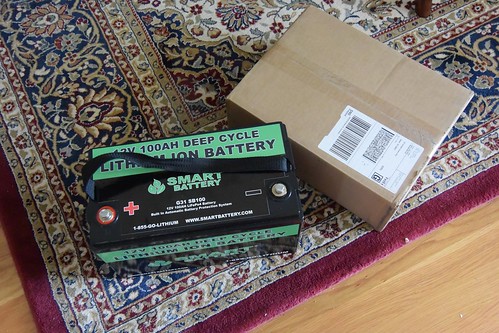
Step 1 was to improve my ramps a bit. I added another layer to give me a couple inches more clearance. The batteries had to be removed with a floor jack since they are so heavy and unwieldily in such a tight space.
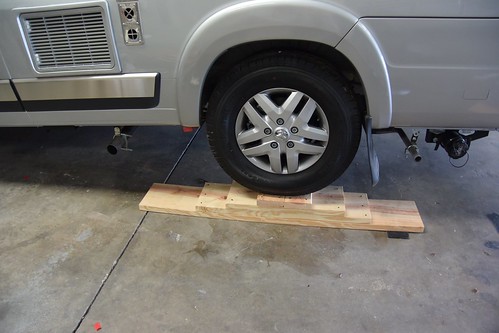
So all this had to be unbolted and removed:
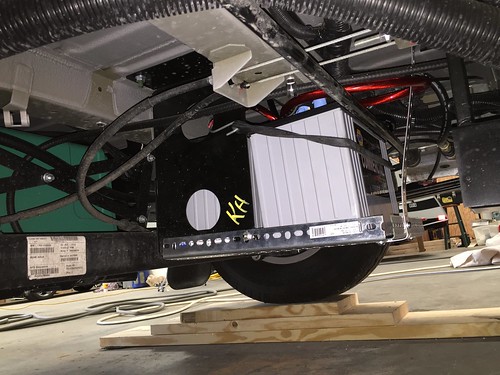
So here is what the battery looks like. These are the only markings. The case looks to be a heavy polystyrene, just like a lead-acid or AGM battery and completely sealed - no way to pry it open.
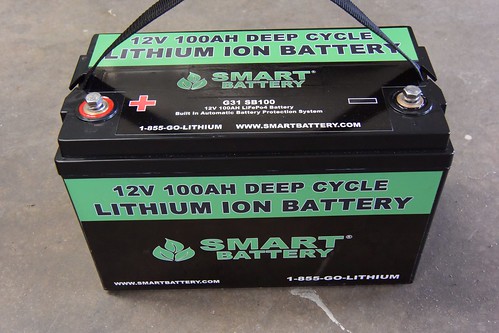
The new converter came well packaged. Surprising how tiny it is.
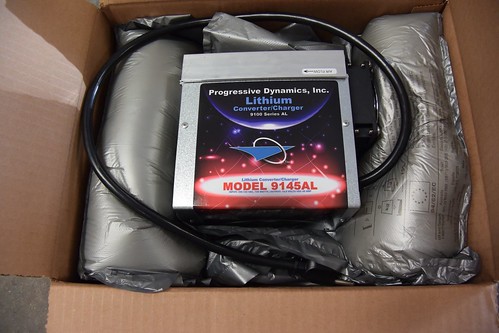
Here it is out of the box. All the wiring connections are exactly the same as the old converter. All the bolt holes are the same for mounting as well, so no need to drill any new holes.
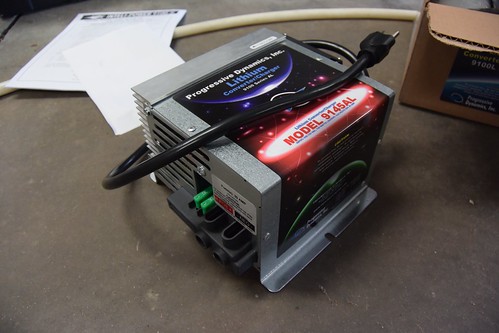
After the old batteries were removed, it was an easy task to secure the new battery in the old tray and tighten the nuts to hold it in place. Lifting it up into the frame was an easy task, as it was only 28 lbs - no need for the floor jack.
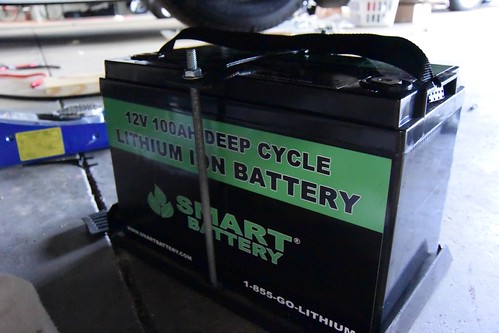
Here it is mounted in place, with all wiring in place. I taped the posts for safety. I also re-installed the pigtail for my portable solar panel, just in case I want to use it.
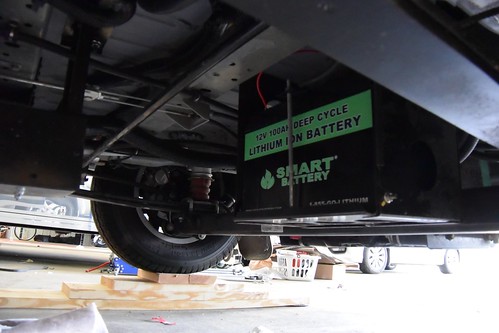
Under the closet floor is where the converter/charger is housed. The panel just pops out. It looks like a rat's nest, but everything is neatly bundled and there is room around it for cooling. There is an opening in this cabinet into the area under the dinette, for running the other electrical wires as well as give some more space for cooling.
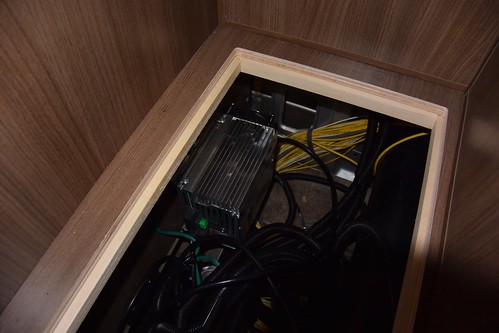
Actually, there was enough slack in the wires, that after I unbolted it from the wall, I could hang it outside the closet and unscrew the connectors holding the pos/neg and grounding cables.

Here you see the new unit bolted in place, all wires connected:
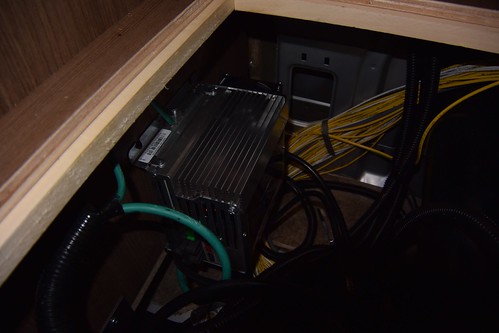
Now with everything complete, I turned on the battery switch to see what I have. Of course, everything came to life on the first try. Below is the voltage I'm reading on the 12v system. A bit higher than I'm used to seeing. Normally you see 12.7-12.8 volts here. Smart Battery told me that the battery would come with about 30-40% charge on it. They also say that they hold 12.8 volts almost all the way to complete discharge. To start, I'm more or less flying blind on what level of charge my battery will have. I will just have to see how it goes for now - I suspect it'll be good for my regular weekend type trips and get fully recharged on the drive home.
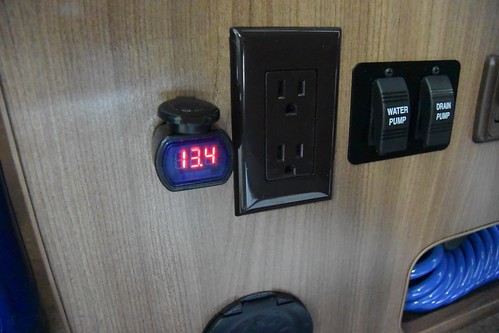
Here is the reading with the power turned on and the charger/converter activated. It slowly ramped up from 14.2 to 14.5 volts. I never did see the max of 14.6 volts, but that may be due to the van's interior 12 volt wiring system. Currently, I have no way to read the voltage at the battery. That may be a next project. The charger manual says that if you get 14.3 volts, it is within spec and is OK. The way this charger works, it should hold voltage always, but reduce amperage as the battery gets full. There should be no danger leaving it running, but I probably will not do that. After it's fully charged, I'll hit the battery disconnect switch and turn off the AC power until next time I want to use the van.
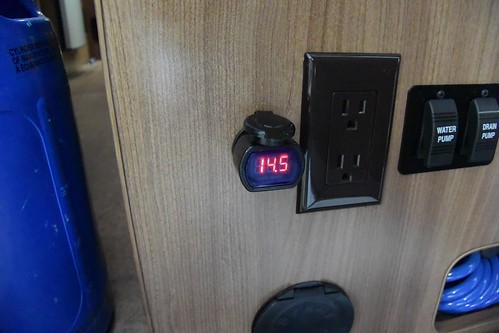
Here are the "old" batteries. They need a new home now. Lots of life still in them.
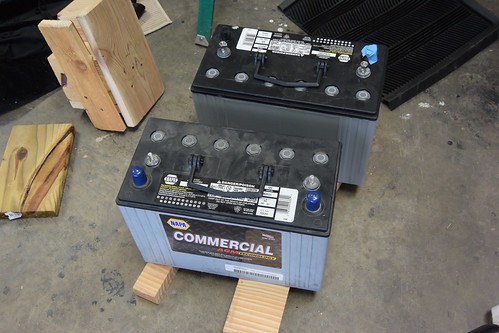
Here is the old converter/charger. It's a good unit. I'll put this on the shelf in case I ever want to go back to the stock install.
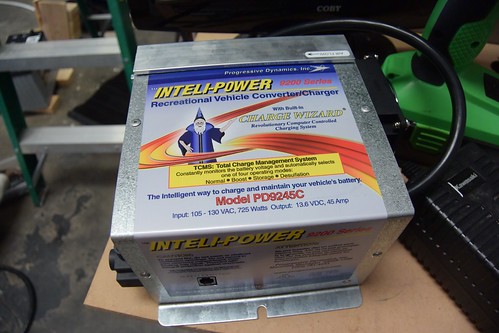
That's basically it. Now to do some endurance testing. Smart Battery says you can hammer these batteries. They have 108 AH total capacity and you can draw them all the way down each time between charges. I doubt I'll be that hard on it, but I have the protection of the warranty. The cycle time promises are 3000-5000 cycles, but that is a tremedously long life - not sure I fully buy it. 1000 cycles would be many years of service and I'd be happy with that. Surely there will be bigger and better (and cheaper) in just a few years time.
A final thing to consider. Lithium batteries will work in the cold, but they are not to be charged below freezing. It can damage them. So what I need to figure out going forward, is how warm this battery gets while it's working. It may generate enough heat (while being discharged) to keep itself above that temp. My van is not a 4 season RV anyways, and I rarely go on trips in the winter months. I could install a 12 volt heating pad, but I'm going to hold off on that for now. I store my van in a heated garage, so I'm not concerned about the winter months if I were to leave it on charge. With lithiums, you don't need to leave them plugged in - they will hold their charge for a year or longer, so I could just let her sit from December to March.
So we'll see how it goes. Hope you enjoyed my project. Please leave a question or comment below.
Follow my blog: www.wincrasher.blogspot.com
Our Facebook group is: Class B Camper Vans
- Labels:
-
Class B
- Mark as New
- Bookmark
- Subscribe
- Mute
- Subscribe to RSS Feed
- Permalink
- Report Inappropriate Content
Jul-31-2015 07:44 PM
I'm anxious to see how this develops for you. I've had a lot of questions about doing this, and up to now neither SmartBattery nor Progressive Dynamics have answered all of them. In particular, I've also heard some discussions about it not being good to continuously move the batteries up to 100% SOC, but it sounds like that's what the PD chargers do. So I'm anxious to get my charger in place and watch how it behaves.
I was also surprised to find that the SmartBattery's don't have an internal BMS - only over- and under-voltage protection. Very glad about that long warranty, as I wonder whether they'll really stay balanced. Time will tell.,,,
'05 Pleasureway Lexor TS
- Mark as New
- Bookmark
- Subscribe
- Mute
- Subscribe to RSS Feed
- Permalink
- Report Inappropriate Content
Jul-29-2015 03:07 PM
The conventional wisdom is a maximum of 3.4 V at "float" (80%) which is 13.6 V at "float" for the four cell battery. As OP noted, LFP systems are set to charge at 3.6 V per cell or 14.4 V for a 4-cell battery (the cells are continuously balanced by BMS and the cells never go over 3.4 V. Since our system is set up with four batteries in series (16 cells total), we are looking at 54.4 V at "float".
Chris of Technomadia did great work when he was first in US (as far as we can tell) to an LFP system in their motorhome. He made mistakes on which he has candidly written. These mistakes along with the correct decisions he made are lessons to all who came after him.
As noted in previous posts, we have only hooked into line power once in two years (for two days when it was over 103 and in the shade at an RV park) so we do not have the problem that Chris had with keeping LFP battery bank at to high a state of charge. We generally start the day at -2 to -4 kW-hrs deficit when we are in high usage mode (sunny skies) and are far more circumspect when we are forced to park in heavy shade. We turn off inverter in these cases since it has a parasitic draw of about 100 W.
Reed and Elaine
- Mark as New
- Bookmark
- Subscribe
- Mute
- Subscribe to RSS Feed
- Permalink
- Report Inappropriate Content
Jul-29-2015 03:01 PM
- Mark as New
- Bookmark
- Subscribe
- Mute
- Subscribe to RSS Feed
- Permalink
- Report Inappropriate Content
Jul-29-2015 02:29 PM
wincrasher65 wrote:
I did some follow up testing over the weekend. Drew down the battery by running the 3 way fridge and everything else in the coach. Twice. First round re-charged with the on-board converter. The second with the alternator.
AND?
- Mark as New
- Bookmark
- Subscribe
- Mute
- Subscribe to RSS Feed
- Permalink
- Report Inappropriate Content
Jul-28-2015 08:29 PM
Follow my blog: www.wincrasher.blogspot.com
Our Facebook group is: Class B Camper Vans
- Mark as New
- Bookmark
- Subscribe
- Mute
- Subscribe to RSS Feed
- Permalink
- Report Inappropriate Content
Jul-20-2015 08:56 PM
reed cundiff wrote:
Have been using LFP for two years and totally satisfied with them. Primarily boondock and have not had to use generator once. We have stayed in a few RV parks when visiting relatives in big cities but have not hooked up but once. We have lasted 6 days in rain forest on Olympic Peninsula and the same at Cave Creek in the Chiricahuas under heavy foliage. Turned the inverter off when not in use and used propane to run hot water heater and fridge. Still used microwave and watched mystery theater on DVD at night.
Did not know that Aussie and US firms were offering LFP as optional original equipment. Liberty Coaches has been offering them as standard on their Liberty Lady line of Prevosts, at $1.8M and up.
Reed and Elaine
They are optional here, but becoming default in some areas
- Mark as New
- Bookmark
- Subscribe
- Mute
- Subscribe to RSS Feed
- Permalink
- Report Inappropriate Content
Jul-18-2015 09:57 AM
Did not know that Aussie and US firms were offering LFP as optional original equipment. Liberty Coaches has been offering them as standard on their Liberty Lady line of Prevosts, at $1.8M and up.
Reed and Elaine
- Mark as New
- Bookmark
- Subscribe
- Mute
- Subscribe to RSS Feed
- Permalink
- Report Inappropriate Content
Jul-15-2015 09:48 AM
Note I left out Great West Vans and Leisure Travel Vans as they are not currently selling Bs.
2021 Advanced RV 144 WB 2500 Class B
2015 Advanced RV Ocean One Class B
- Mark as New
- Bookmark
- Subscribe
- Mute
- Subscribe to RSS Feed
- Permalink
- Report Inappropriate Content
Jul-14-2015 04:37 PM
Lithium batteries are far smaller and lighter than lead acid batteries of similar capacity, but apart from both having positive and negative electrodes and electrolyte, they are almost totally different.
They were first offered in locally made RVs by Kimberley Kampers in 2012. Off-road caravan builder Bushtracker claims that 98% of all buyers now specify a lithium battery system. There are also a number of DIY systems (of varying success)
- Mark as New
- Bookmark
- Subscribe
- Mute
- Subscribe to RSS Feed
- Permalink
- Report Inappropriate Content
Jul-13-2015 01:14 PM
Follow my blog: www.wincrasher.blogspot.com
Our Facebook group is: Class B Camper Vans
- Mark as New
- Bookmark
- Subscribe
- Mute
- Subscribe to RSS Feed
- Permalink
- Report Inappropriate Content
Jul-13-2015 01:03 PM
Some writings say that an LFP cell should be stored at 80% SOC or below. However, the jury seems to be out on this, as it is on a lot of LFP usage.
We have 1.4 kW of solar panels and 8.6 kW-hr (48 V nominal) of LFP and are delighted with both since we are effectively solar autonomous.
Reed and Elaine
- Mark as New
- Bookmark
- Subscribe
- Mute
- Subscribe to RSS Feed
- Permalink
- Report Inappropriate Content
Jul-13-2015 08:06 AM
The battery appeared to be room temperature - I could not detect it being warm.
To be safe, I unplugged the shore power and hit the disconnect switch, so it will stay dark until next time I use the van.
Follow my blog: www.wincrasher.blogspot.com
Our Facebook group is: Class B Camper Vans





